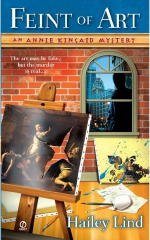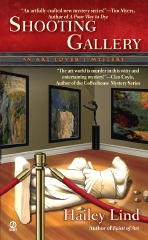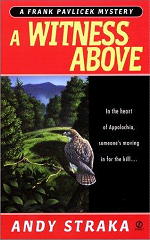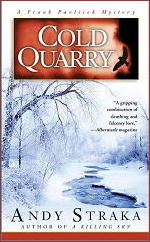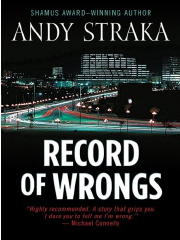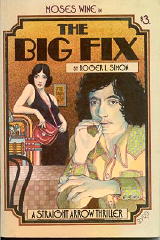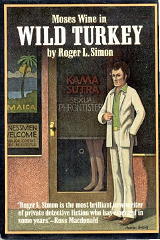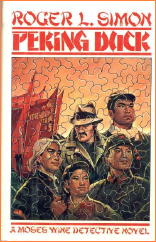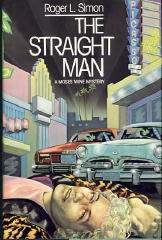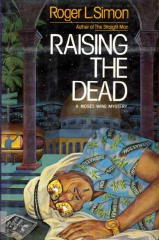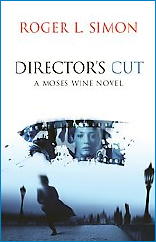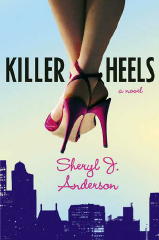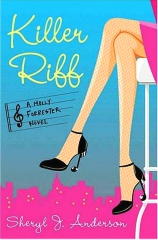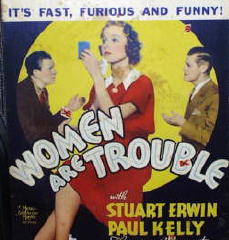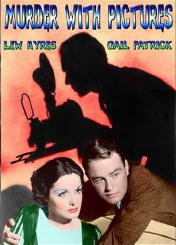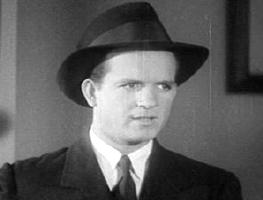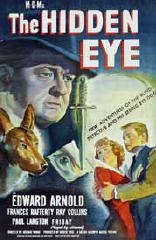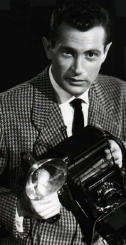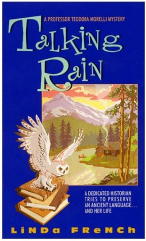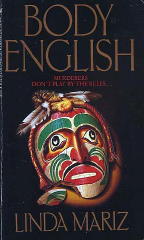August 2008
Monthly Archive
Thu 14 Aug 2008
FIRST YOU READ, THEN YOU WRITE
by Francis M. Nevins
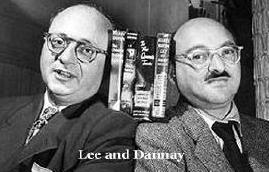
As all mysteryphiles know, “Ellery Queen” was both the joint byline of first cousins Frederic Dannay (1905-1982) and Manfred B. Lee (1905-1970) and the brilliant sleuth who starred in most of their mysteries.
It’s also well known that, for all but the first years of their long joint career, Fred’s function was to devise lengthy plot synopses which Manny would flesh out to novel or story length.
This was their division of labor when the Ellery Queen radio series debuted on CBS in the summer of 1939. What was not known outside the inner circle was that, after his first wife died of cancer in 1945, Fred was so overwhelmed with raising their two small children and keeping Ellery Queen’s Mystery Magazine afloat that he simply couldn’t continue coming up with new plots.
After a few false starts, the writer chosen to take over much of Fred’s function on the series was Anthony Boucher (1911-1968). Since Tony lived in Berkeley, California and Manny on the East Coast, the arrangement required correspondence between them on almost a daily basis. That correspondence, which rivals Gone with the Wind in word count, is preserved at Indiana University’s Lilly Library.
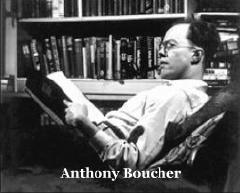
I’ve made several trips to Bloomington to immerse myself in those letters, which are fabulously interesting for any number of reasons. Some of them are close to indecipherable since they deal with the plot minutiae of radio dramas that have apparently ceased to exist in audio form.
But the rest! Working at opposite ends of the country and under wartime and immediate post-war traveling conditions, Tony and Manny almost never met in person. But from their correspondence alone the devout Catholic and the agnostic Jew grew to be closer than brothers, and their letters range all over the map, from the health problems of their children to Hiroshima and the Cold War and anti-Semitism.

Manny’s letters tend to be much longer and more irascible and clearly he was using them to vent. His rants about the confederacy of dunces he had to deal with in the broadcasting world offer some remarkable insights into the medium – as long as one keeps in mind that, being a classic type A personality and a past master at getting hot under the collar, he may not have been the most objective witness in the world.
During much of his time collaborating with Manny, Boucher was also writing scripts for the Sherlock Holmes radio series, which between 1939 and 1946 starred Basil Rathbone and Nigel Bruce, the Holmes and Watson of Universal’s movie series.
“Compared to EQ, Holmes scripts practically write themselves,” he told Manny in one letter (13 September 1945), “and the EQ occupies by far the major portion of my working week…. You have no idea of the number of ideas that I worked on for days only to reject because I discovered an ineradicable flaw that would exasperate you….”
As if to reassure Manny that he wasn’t the only man in radio who was surrounded by jerks, Boucher in his letters often recounted his travails with the Holmes program.
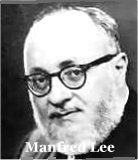
“On Holmes, either my collaborator [Denis Green] or I am – is – I hate that kind of sentence – one of us is present at every rehearsal-and-broadcast. And a good thing, we find: not only directors but star actors can get the damndest ideas they have to be gently talked out of.” (28 January 1945)
“We do at least have a first-rate man at the control board; but our sound technicians are two of the clumsiest louts that ever held a union card and all the things about time for commercials and cutting dialog to the bone… God does all that happen regularly to us. Especially since the sponsor switched announcers on us because the new one reads slower!” (5 July 1945)
But these problems were as nothing compared with what happened at the beginning of the 1946-47 season, when Rathbone left the series for the Broadway stage and was replaced by Tom Conway. “The new producer on the show … is a pretentious and arrogant boor with a great deal of very real talent for production and writing – in some ways the ablest (and also the most offensive) man I have known in radio. He is convinced that only he knows anything about Holmes…
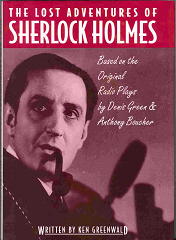
“He is bent on reducing Holmes to the simple formula of heavy melodrama and heavier low comedy that has driven Holmes enthusiasts screaming from their radios and theaters. And he assumes automatically that his duties as producer include replotting and rewriting of all scripts….” (14 October 1946)
“My favorite enemy … with his constant miscasting, his incredibly inept music, and his campaign of forcing me [and Denis Green] off and replacing us by astonishing scripts from his ex-wife and a protégé, has succeeded finally in driving Holmes off the air…. I don’t know what this will mean. The director will try to argue that this is all simply due to Rathbone’s absence. But if [he] is kept on the show … I’m pretty certain to be entirely off Holmes in the fall.” (30 June 1947)
“Did you read in the trades what’s happened to Holmes? It’s been sold to a cheap NY outfit, to be an extreme low-budget show – cheap production, no actors over scale (including Holmes & Watson), scripts for pennies – and $1,000 a week to Denis PS Conan Doyle [who was Sir Arthur’s son and one of his literary executors].”(25 July 1947)
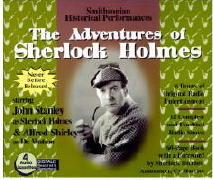
Taking over the parts of Holmes and Watson were the long-forgotten John Stanley and Alfred Shirley. “I’m definitely out on Holmes – not even a hope of some income from repeats… I think this may be the most severe fatality Holmes has suffered since the Reichenbach Falls – but then he survived even that…” (12 August 1947)
As far as I know, no Sherlockian has ever delved into Boucher’s running commentary on the Holmes radio series, but it’s a job eminently worth doing. And so is the assembling of a full-length book of the Boucher-Lee correspondence, which chronicles one of the strongest, deepest, most fascinating literary friendships of the 20th century and, in the world of mystery fiction, perhaps the strongest and most fascinating of all.
Thu 14 Aug 2008
Posted by Steve under
Authors ,
Reviews1 Comment
A REVIEW BY CURT EVANS:
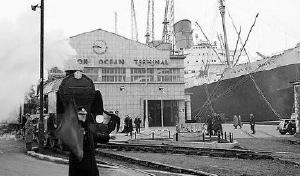
JOHN RHODE – Death on the Boat Train. Collins, UK, hardcover, 1940. Paperback reprint: Collins, UK, 1940s (cover shown). Dodd Mead, US, hardcover, 1940.
How died the man, dressed incognito, found dead from no discernible means after having traveled on the boat train of the title? Foul play of course turns out to be involved, but the discovery of the killer is by no means simple.
Jimmy Waghorn, just married to Diana, his love interest from Death Pays a Dividend (Collins, 1939), is put on the case, which naturally leads eventually to the involvement of Dr. Priestley, who makes a couple of very significant deductions (one from his armchair, the other after on-scene investigation, underling Harold in tow).
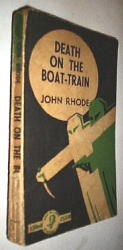
Death on the Boat Train is one of the most Croftsian of the Rhode novels, with transportation, alibis and many subsidiary matters involved in the resolution of the murder mystery. The solution hinges on a straightforward enough matter, but one that the reader may well miss.
Characterization is stock, but fairly pungent, with a sexually profligate industrial magnate, a cynically designing, gold digging “personal secretary” and a dope junkie, among other modernish characters.
Diana Waghorn makes sporadic, yet welcome, appearances, making the reader wish Street had done more with this character in more of his later novels. And Jimmy and his boss Hanslet manage to be constantly wrong without looking stupid, not something they always manage in other books.
All in all a pleasing job for fans of this author, if somewhat more Croftsian than Rhodeian in mechanics.
[COMMENT.] 8-14-08. This is Steve. For an earlier exchange of comments between Curt and myself about John Rhode, see my review of Three Cousins Die (Bles, 1959), a book that neither of us believes is among his best.
Wed 13 Aug 2008
REVIEWED BY WALTER ALBERT:
HAILEY LIND – Brush with Death. Signet, paperback original; July 2007.
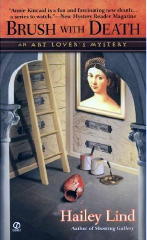
Annie Kincaid’s family background is dominated by a talented grandfather who’s a notoriously successful painter of art forgeries, but Annie, who’s inherited his artistic talent, is trying to live a more conventional life by keeping a career as a “faux finisher” afloat. However, she continues to find that her grandfather’s notoriety and her own somewhat checkered past keep interfering with her good intentions.
The books keep getting better, and the most recent, and third in the series, has Annie attempting to authenticate a possible original Raphael painting masquerading in a local cemetery as nineteenth century copy, and had me turning the pages with the fervor of the true convert.
The two sisters co-writing the mysteries as Hailey Lind have a somewhat jaundiced view of the art scene and each chapter is headed by quotes by a famous painter or art historian countered by a cynical restatement credited to Georges LeFleur (Annie’s grandfather) that reflects the authors’ viewpoint.
A paperback original series that outclasses many of the hardcover series I read.
Bio-bibliographic Data:
HAILEY LIND. One half of “Hailey Lind” is Julie Goodson-Lawes, a San Francisco Bay Area muralist and portrait painter with her own faux finishing and design business. She graduated from UC Santa Cruz with a major in Latin American studies before earning Masters Degrees in Anthropology and Social Welfare from the State University of New York at Albany.
The sister who’s the other half of the two-author writing team, Carolyn J. Lawes, received a BA in History from the University of Santa Clara, and an MA and a PhD in History from UC Davis. She is currently an Associate Professor of History at Old Dominion University in Norfolk, Virginia, where she specializes in American women’s history.
Feint of Art. Signet, pbo, January 2006. Nominated for an Agatha. [Best First Novel]
Shooting Gallery. Signet, pbo, October 2006.
Brush with Death. Signet, pbo, July 2007.
>>
[UPDATE] 08-14-08. An email reply from half of the Hailey Lind combo:
Hello Steve,
Thank Walter for me for the lovely review! I especially like the part about out-classing the hardbacks… I’ll keep that one by my computer when I need a boost.
Unfortunately, Signet has decided not to renew the contract for more titles in the Art Lover’s Mystery series…at least for the time-being. Though the books have garnered a lot of support, been nominated for awards and translated into foreign languages, they simply didn’t sell enough across the board. As I’m sure you know, book publishing is a cutthroat business these days.
I’m working on some other projects now (including one about historic home renovation, and another featuring a witch with a vintage clothing store!), but I haven’t given up on Annie Kincaid and the gang–they’re much too much fun. Book 4 in the series, Arsenic and Old Paint, is almost finished, and I feel confident that one way or another it will be published, along with numbers 5 and 6 which are already plotted.
I’ll try to keep you posted as to my progress.
Thanks again,
Hailey (Julie–the artist half)
Hailey Lind
Feint of Art; Shooting Gallery; Brush with Death
www.haileylind.com
www.artloversmysteries.blogspot.com
www.truefauxdesigns.com (for art lovers…)
Wed 13 Aug 2008
Posted by Steve under
Authors ,
Reviews1 Comment
ANDY STRAKA – A Killing Sky.
Signet, paperback original; 1st printing, April 2002.
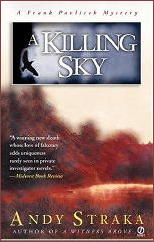
Private eye novels have been around for a long time, and it has to be tough for a new writer on the block to come up with a new idea, but Andy Straka has come up with a couple that are new to me. This is the second case featuring Charlottesville (VA) private eye Frank Pavlicek — the first being A Witness Above from 2001 — and I think he’s going to be around for a while.
There are also some things done here that have been done better somewhere else, but I’ll go with the pluses first. Pavlicek’s a single father, and his teen-age daughter, a college student, wants to follow in his footsteps. As a computer whiz, she’s ready to help out when e-mails have to be recovered from hard drives, records tracked down and similar high-tech wizardry far beyond Sam Spade’s wildest dream. (And if he had a daughter, we never knew that either.)
Pavlicek, like the author, is also a falconry enthusiast. Not that it adds anything to the case he’s solving, except for the occasional break in the action, but never unwelcome.
He’s hired by one of a disreputable (philandering) congressman’s twin daughters to help find the other, who’s been acting strangely and has suddenly gone missing. Lots of Washington dirt in the case, in other words, and many of the participants have played their roles before: cheap thugs as bodyguards, the congressman’s ex-floozy girl friend now turned tattle-tale TV show hostess, obnoxious staff assistants and the like.
And other than Pavlicek’s daughter, someone Spenser (so far) has never had anyone similar to tag along with him, the rest of the returning cast could be moonlighting from Robert B. Parker’s books (lovely lady friend, macho multi-talented guy friend). With similar laconic dialogue to boot. Which is not bad, in itself, but it’s not exactly new either.
A greater displeasure was twofold. The case is undone with a nice combination of old-fashioned detective footwork and new-fangled computer savvy, but that old standby, pure luck, still comes in handy to crack it open. Not to mention the next to utter incompetence of the bad guys, allowing Pavlicek and his buddy Toronto to invade their compound without their ever looking up.
As a summary: promising, and maybe a contender someday. At the least, worthy of a few more cases to come. (I liked the daughter idea.)
[UPDATE] 08-13-08. It looks like I was wrong. And this is discouraging: it also seems that award nominations don’t help if sales don’t match up to expectations. No big surprise there, but apparently there were only three Frank Pavlicek books in the contract, and that’s all there’s going to be.
Here’s Andy Straka’s complete mystery-writing resume. Note the good news: a stand-along novel just published earlier this year:
A Witness Above. Signet, pbo, May 2001. FP = Frank Pavlicek. Shamus, Anthony, and Agatha Award nominations [Best First Novel.]
A Killing Sky, Signet, pbo, April 2002. FP. Anthony nomination [Best Paperback original.]
Cold Quarry. Signet, pbo, April 2003. FP. Shamus winner [Best Paperback original.]
Record of Wrongs. Five Star, hardcover, Feb 2008.
>>>
[UPDATE #2] Later the same day: an email from Andy Straka, with welcome news:
Steve,
Thanks for the nod.
Also, good news! The Shamus Award-winning Pavlicek series is being resurrected. The fourth book in the series, Kitty Hitter, will be published in hardcover by Five Star/Gale/Cengage in August 2009. (See synopsis below.) Earlier titles to be re-released in trade paperback. More details will be posted on my website as they develop.
— KITTY HITTER by Andy Straka (to be released August 2009) (Gale/Cengage Learning)
No one would mistake Virginia private investigator and falconer Frank Pavlicek for Ace Ventura. But when the ex homicide detective is asked to return to New York City to help find a physician/animal rights activist’s missing cat, the stage is set for one of the most bizarre cases of Frank’s career.
Are the doctor’s accusations true? Has the eccentric developer of her luxury apartment building actually hired a hit man to kill her pet by stealing the poor creature and hunting the kitty down with a bird of prey? Turns out, the doc and some of her fellow apartment owners are embroiled in a rancorous legal dispute with the developer. Other pets are missing too and witnesses claim to have spotted a specter-like figure prowling Central Park at night carrying a giant owl.
With the help of his daughter Nicole, sometime partner Jake Toronto, and tough-nosed PI Darla Barnes, Frank soon discovers more is at stake than any of them had imagined. Chasing the mysterious falconer, they stumble upon an anonymous, half-dead child. Darla is shot and seriously wounded. To make matters worse, a newspaper reporter more interested in a bizarre story than in pursuing facts interferes along with competing camps of protestors. Not to mention Frank’s rekindled romance with erstwhile flame Marcia D’Angelo.
In the end, both the good doctor and the developer must come clean about their respective agendas, exposing a true malice that has escaped unnoticed. Overcoming such an evil will take every skill in Frank’ s hunting bag … and a sacrifice by a heart as big as New York City and all outdoors.
Mon 11 Aug 2008
ROGER L. SIMON – California Roll.
Warner, paperback reprint; 1st pr., June 1986. Hardcover edition: Villard, March 1985. Trade paperback: I Books, Jan 2001.
I think what I will do is to quote private eye Moses Wine in his own words. The first three paragraphs of California Roll will do as much to set the stage as anything that I could say:
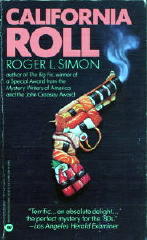
I never sold out before because nobody ever asked me. In all it took around twenty minutes. It would have taken around three, but the guy on the other end was so profusely apologetic, he wouldn’t give me a chance to say yes.
Actually, if had any idea of my then depressed state, he might have known that all he had to do was whistle. I was in the midst of a pronounced mid-life crisis somewhere between Gail Sheehy’s Passages and the advice column of a minor metropolitan daily. I felt like a human cliché. Most of the time I would sit around in my room in my bathrobe, listening to Leadbelly albums and bemoaning my situation: three months shy of my fortieth birthday and still a private detective with nothing to show for it but a leaky two-bedroom cottage on Wonderland Drive and a battered Porsche with a sever transmission problem. My political ideals, when I could remember them, felt like the rehash of a twenty-year-old Marcuse paperback. My work, when I had some, was boring. And my body, however hard I fought against it, was beginning its slow, inexorable slide to oblivion.
Beyond this, my kids were growing up and didn’t want much more to do with me than an occasional overpriced visit to a sushi bar, while my ex-wife, who had dropped out of law school to live with a movie producer with a chalet in Vail, still asked for alimony. And to top it all off, my own lovelife was in the doghouse since the glorious Louise went back to her nitwit stockbroker husband after three years because, after all, she had her security to think about. And all around me my sixties buddies were getting rich. “Fuck it, Moses,” they would say. “Reagan’s in the White House. If you can’t lick ’em, join ’em!”
Moses was, as far as I have been able to determine, the first counter-cultural PI in the books, starting out as a pot-smoking California hippie detective in 1973 and having a whole career of life-altering adventures from that point on, but always the same person, always with new problems, or so his books have been described to me. (I’m relying here on some of the comments I found after a quick Google through the Internet, with (as usual) Kevin Burton Smith at thrillingdetective.com having the most concise but illuminating things to say.)
Here’s the entire list of Moses Wine adventures. I’ve read only two of them, I’m sorry to say.
The Big Fix. Straight Arrow, trade pb, 1973.
Andre Deutsch, hc, UK, 1974.
Pocket, pb, March 1974.
Pocket, pb, September 1978.
Warner, pb, July 1984.
I Books, trade pb, July 2000.
Wild Turkey. Straight Arrow, hc, 1974.
Pocket, pb, February 1976.
Warner, pb, September 1984.
I Books, trade pb, July 2000.
Peking Duck. Simon & Schuster, hc, June 1979.
Detective Book Club, reprint hc, 3-in-1 volume, Sept-Oct 1979.
Warner, pb, September 1987.
I Books, trade pb, November 2000.
California Roll. Villard, hc, March 1985.
Warner, pb, June 1986.
I Books, trade pb, January 2001.
The Straight Man. Villard, hc, September 1986.
Warner, pb, October 1987.
I Books, trade pb, June 2001.
Raising the Dead. Villard, hc, July 1988.
Warner, pb, August 1989.
The Lost Coast. Harpercollins, hc, 1997.
I Books, trade pb, March 2000.
I Books, hc, May 2003.
Director’s Cut. Atria, hc, June 2003.
I Books, trade pb, December 2005. [Scheduled but possibly never published.]
Getting back to California Roll, however, and as you can probably imagine, the match-up of Moses Wine with corporate California — the computer business in its early stages — does not go well. There is a parallel theme, not thinly disguised, in the fact that Alex Wiznitsky (aka The Wiz), the head of Tulip (not Apple), newly worth $234,000,000 and who hires Moses to be the new head of security — he also finds that immense, immeasurable wealth is not what it is cracked up to be. He, the Wiz, would rather be, one feels, back in his garage tinkering around on his own.
He, the Wiz, also says, on page 13, “They’re t-trying to take the company away from me, Moses.”
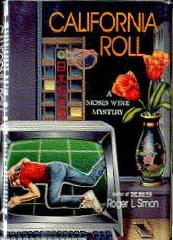
I don’t think the plot of the mystery adventure novel that follows makes a whole lot of sense, although it certainly follows the usual path of a private eye novel in practice, although with a sense that the latter is not entirely the sort of story Mr. Simon intended to tell.
Characters come on stage to amuse and entertain us for a while, and then they are seemingly jettisoned when the story verves off in another direction — to Japan, say, for several chapters — and then back again to California.
One excellent creation along these lines is Mr. Hodaka, a translator Moses hires in Japan who turns out also to be the writer of Japanese pulp detective stories and who eagerly finds the opportunity to be of assistance to Moses along those lines to be very exciting, along with his fellow members in the Maltese Falcon society. A girl named Laura Suzuki, on the other hand, whom Moses makes love to on page 62 (in brief but explicit detail), finds her role in the story (later on) much less to her liking.
On page 170 is a sort of semi-capsule summary: “… it was a two-tiered game … being played out on one level by large corporate entities and nation-states and on another by human beings struggling desperately for survival in this sad vale of tears.”
Which, if nothing else I’ve said so far, may give you an inkling of where either the book succeeds or fails. Or if it does not, here is another take on the book’s intentions — and ordinarily I perhaps should not do this, which is to quote the last two lines of the book (or that is to say, to quote a quote from Hagakure: The Book of the Samurai) — but if you were paying attention up above, there’s nothing in this that will surprise you, not an iota:
“Human life lasts but an instant. One should spend it doing what one pleases. In this world fleeting as a dream, to live in misery doing only what one dislikes is foolishness!”
Sun 10 Aug 2008
Posted by Steve under
Authors ,
ReviewsNo Comments
SHERYL J. ANDERSON – Killer Cocktail
St. Martin’s; paperback reprint, May 2006. Hardcover: St. Martin’s Press, August 2005.
Killer Cocktail is the second in a series of what are now three cases solved by Mollie Forrester, a New York City based advice columnist (and wishful crusading reporter) for fashionable Zeitgeist magazine. In order, here they are:
Killer Heels. St. Martin’s Press, May 2004. Paperback: June 2005.
Killer Cocktail. St. Martin’s Press, August 2005. Paperback: May 2006.
Killer Deal. St. Martin’s Press, July 2006. Paperback: not yet scheduled.
Unnamed Molly #4. “In the works.” [See the update below.]
According to Booklist, the authors are a pseudonymous husband-and-wife writing team, and if that is the case, the copyright notice in Cocktail gives it all away: copyright © by Sheryl J. Anderson & Mark Edward Parrott. On the other hand, the author’s website does not admit to any other author than the female half of the husband-and-wife team, so I will leave the question open to more diligent detectives than I.
I suppose I should also admit upfront that a case of murder that are tackled and cracked by a team of female friends in the city is a phenomenon that I am somewhat unaccustomed to and/or unfamiliar with. Whether or not it is a rare phenomenon I do not know, not having read any of Stephanie Plum’s adventures, for example, nor ever (in regards to non-mystery fiction) having seen Sex in the City.
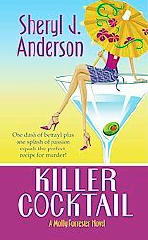
Not that there is any sex in Killer Cocktail, but both examples are suggestions put forth by reviewers who’ve posted comments on Amazon in attempting, and I presume accurately, to inform readers just what kind of book this one by Sheryl Anderson happens to be.
(If truth be said, I do not believe such mystery novels are rare. I am perfectly content to assume that I have not (yet) happened upon them, and if I simply keep reading, I will come across another one soon.)
Mollie’s female friends are, to enumerate: event planner Tricia Vincent, whose brother’s prospective bride falls to the titular poisoned cocktail in the Hamptons only hours before the wedding; and Cassady Lynch, successful lawyer. Mollie’s male friend and as such, an item of significant interest to her, is NYPD homicide detective Kyle Edwards, who is therefore out of his jurisdiction in the Hamptons.
How close a male friend Kyle is to Mollie, even at the risk of repeating myself, is a matter of some reflection and concern throughout the book, including some strong attacks of jealousy perhaps whenever Detective Darcy Cook of Suffolk County Homicide is on the scene, which is often, as the Hamptons do happen to be in her jurisdiction.
The book is funny, light, breezy and so tightly told that it made my jaws ache. There is also (as hinted above) a good deal of internal pondering – I have neglected to mention that Mollie herself tells the story – and there are both a sizable number of suspects – it was a large party at which the victim died after all – and there are a good number of pages (over 300) to read before the end is in sight.
In this regard, I have been debating whether or not to tell you this, but I guess I am, for whatever it’s worth. I stalled out round the 250 page mark and didn’t pick the book up again for a week.
But I’m glad I did. Pick it up again, that is, even above and beyond the consideration of the time already invested. Perhaps you have to be in the right mood to begin with, as the author doesn’t concede a thing to the reader, nor will she diverge from her way of telling her story for anyone or anything. I like an author with a goal and a sense of purpose in mind, and one who sticks to it.
And anyone who can write a passage like the one following, taken from page 256, is worth reading, no matter what. Mollie is in the City at the time:
“I was only about ten blocks from the office and I thought the walk might help my hangover as well as my thought process. Besides, I love walking in the city, throwing myself into the river of people moving up and down the island all day and most of the night, and letting the current carry me along. It’s not good for the shoes, but it’s good for the soul. The pace and size of the city make it easy to feel disconnected, but when you walk down the sidewalk and just spend a few minutes watching the huge spectrum of people rushing along right beside you, worrying about being disconnected, too, sometimes that’s a connection in itself and you feel part of something larger than your own panics and problems. Maybe you’re just a fish swimming along with a school, maybe you’re a star in a constellation, maybe you’re part of the human race. Whichever, you’re not alone.”
— June 2006
[UPDATE] 08-10-08. Killer Deal came out in paperback from St. Martin’s in July 2007. The previously unknown title of book #4 is Killer Riff (St. Martin’s, hc, Nov 2007; ppbk, July 2008).
In spite of an excellent sales ranking for the series on Amazon, there is no mention of a fifth book on Sheryl Anderson’s website. (The paperback edition of Riff, which just came out is ranked #89,277. (Out of over six million books with sales rankings, this is excellent.)
And if it matters, I still have not seen Sex in the City or read a Stephanie Plum book. Someday, I’m sure.
[UPDATE #2] 08-13-08. Excerpted from an email send me by Victor Berch:
Hi Steve:
… As for Sheryl J. Anderson, her full name is Sheryl June Anderson, born in LA 10 March 1958. Started out as a playwright. Parrott was born Oct. 21, 1951 in Kern County, CA.
Don’t know who’s going to use this info as no one as far as I know is carrying on Al Hubin’s good work from 2001 on up.
Sat 9 Aug 2008
Tise Vahimagi left the following as a comment to the second of three reviews I posted this past week of George Harmon Coxe’s detective fiction. As usual, the information that Tise provides warrants a post of its own. Most of the movies he mentions exist. I’m not so sure about the TV shows, but there’s always hope.
— Steve
The George Harmon Coxe reviews and views and responses are fascinating. An author I’ve always been aware of yet, rather shamefully, one that I have not yet read. I am aware, however, of his big and small screen associations. (Which doesn’t mean that I have seen most of these either.)
But if several of the following films and TV work were easily available, I’m sure there would be much pleasure to be had in the viewing (or at least, the experience). While one can respect and appreciate that viewing screen adaptations of any author’s work is not the same as experiencing the original art of the written word, there remains with me a certain fascination of how the literary concept is translated into a (albeit condensed) visual storytelling form. An art in itself, of course.
Research shows that the following have Coxe credentials (in one form or another) and are worthy of further investigation. Well, some of them, perhaps!
Women Are Trouble (1936, d. Errol Taggart). With Stuart Erwin as Matt Casey, a newspaper reporter following up a series of robberies and murders. Screenplay by producer Michael Fessier, from story by GHC.
Murder With Pictures (1936, d. Charles Barton). Lew Ayres is Kent Murdock in a plot that kicks off with the murder of a gangland lawyer. Screenplay by John C. Moffitt and Sidney Salkow, from story by GHC.
The Shadow Strikes (1937, d. Lynn Shores). Based on the story “The Ghost of the Manor” by Maxwell Grant in The Shadow (15 June 1933). Rod La Rocque as Lamont Cranston. Screenplay by Al Martin, from adaptation by Martin, Rex Taylor and GHC. Intended by producer Colony Pictures to be the first of four “Shadow” films.
Here’s Flash Casey (1937, d. Lynn Shores). Based on the short story “Return Engagement” by GHC in Black Mask (March 1934). Eric Linden is Flash Casey. Screenplay by John Krafft.
Arsene Lupin Returns (1938, d. Geo. Fitzmaurice). Silky Melvyn Douglas was the silky Arsene Lupin. Based on characters created by Maurice Leblanc, the story and screenplay was by James Kevin McGuinness, Howard Emmett Rogers and GHC.
The Hidden Eye (1945, d. Richard Whorf). Based on the novel The Last Express (1937) by Baynard Kendrick. Screenplay by GHC, Harry Ruskin, from story by GHC. One of the two pleasing MGM Captain Duncan Maclain films starring Edward Arnold (the other being Eyes in the Night, 1942).
For the home screen, there was Crime Photographer (CBS, 1951-52) featuring Richard Carlyle (brief stint, 1951) and Darren McGavin (1951-52) as Casey of The Morning Express.
“The Category is Murder” (1957) for Kraft Television Theatre (NBC), about a TV quizmaster who drops dead of poisoning during a show. Betsy Palmer and Gene Lyons featured. And that’s about all I know about this one. GHC as teleplay or story source?
“Focus on Murder”(1958, d. Bill Corrigan) for Kraft Television Theatre featured Si Oakland as Kent Murdock in a story about a Pulitzer Prize reporter found murdered in his apartment. Mel Goldberg adapted from novel by GHC.
“Mission of Fear” (1963, d. Harvey Hart) for U.S. Steel Hour (CBS) involved the statuesque Salome Jens and Robert Horton in a blackmail story written by Richard F. Stockton [from story/source by GHC?].
A list of credits without benefit of personal insight or opinion can be somewhat dreary, I know, but I have not been fortunate enough to view most of the above titles, especially the rare TV work. Perhaps others with more opportune moments of viewing access may offer a more satisfying sense of form and flavour.
For my part, it is hoped that I have viewing pleasures to look forward to — one day.
Sat 9 Aug 2008
LINDA FRENCH – Coffee to Die For.
Avon, paperback original. First printing, December 1998.
Linda French is the author’s maiden name, and this is second of three mystery novels she wrote under this byline. All of them take place in the northwestern corner of Washington state, with the leading character in each of them being Teodora “Teddy” Morelli, a history professor who lives in Bellingham. According to Google is about 85 miles north of Seattle, which is where most of Coffee to Die For takes place.
Not so coincidentally, according to Amazon, Linda French is a history professor who lives in Bellingham, Washington.
Based on her entry the Revised Crime Fiction IV, by Allen J. Hubin, here’s a list of her mystery fiction in book form:
FRENCH, LINDA. Pseudonym of Linda Mariz, 1948-
* Talking Rain. Avon, pbo, April 1998.
* Coffee to Die For. Avon, pbo, Dec 1998.
* Steeped in Murder. Avon, pbo, Dec 1999.
Under her married name, Ms. French also wrote the following pair of mysteries:
MARIZ, LINDA (Catherine French) 1948- . Pseudonym: Linda French.
* Body English. Bantam, pbo, Feb 1992.
* Snake Dance. Bantam, pbo, Aug 1992.
Anthropologist Laura Ireland, who’s also based in Washington state, is featured in both of these, although the second one takes place in Louisiana’s Cajun country. (She’s also a tall championship volleyball player, while Teddy Morelli is short, maybe five foot three.)
Of the five, Coffee to Die For is the only one I’ve read, and while one should never say “never,” all things considered, I’m not likely to read another, or at least not right away.
It’s not that it’s badly written, mind you, for it’s not. It’s not, shall we say, my cup of naturally flavored chocolate coffee. In fact, I suspected this from the very first paragraph, which I will quote:

“From the balcony, Teddy Morelli dumped a forty-pound bale of fiberfill over the rail. She stared into the hopper, mesmerized as the compressed air of the stuffing machine ravaged the bale, plumping it to thirty times its former volume. A single block of fiberfill would fatten seventy-five of her sister Daisy’s exquisite woolen bunnies. But down on the floor of Bunny Business, Inc., her sister was not happy.”
How cozier could you get than a mystery full of woolen bunnies?
Dead, eventually, is Daisy’s philandering husband Leo, a scientist who (a) has recently developed the aforementioned naturally flavored chocolate coffee plant, and (b) has even more recently given himself a present in the form of a young, new (and beautiful) lab assistant by the name of Molly Thistle.
When he’s found murdered in his laboratory office, no one sheds a tear. Teddy and Dolly assume that Molly did it, only to discover that she has an unbreakable alibi. It is not known whom the police suspect, unless it is Daisy, since they are visible on the scene for a maximum of seven pages out of 210 in all.
Which means that the percentage of professional police participation is just over 3%. I’ve heard of low-carb diets, but this is far too low for me.
The rest of the book is filled with Teddy’s extended family and circle of friends, along with some goons with whom Leo was partner’s with in some sort of cannabis deal, now gone bad. Among the circle of friends, by the way, is Teddy’s ex-husband Aurie Scholl, a knee surgeon who works with the Seahawks, who’s hoping they can get back together sometime.
Four out of five reviewers on Amazon left positive comments, but keeping in mind that I’m not a member of the target audience for books like this, I need something more solid to chew on.
Fri 8 Aug 2008
GEORGE HARMON COXE – Fashioned for Murder.
Dell 678; paperback reprint; no date stated, but probably 1953. Hardcover edition: Alfred A. Knopf, 1947.
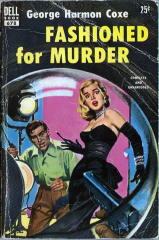
Take a look at the cover of the paperback edition and compare with the one on the hardcover. Both are appropriate for their respective venues — sales mostly to libraries for the hardcover, where the artwork on dust jacket was all but incidental, versus sales on newsstands and drugstore spinner racks. The one on the paperback is nothing but eye-catching, and it does its job well. Besides telling you something about the story itself, wouldn’t it make you a whole lot more in the mood to fork over the 25 cents to took back then to take it home?
And in the credit-where-credit-is-due department, the Dell cover was painted by Fred Scotwood, a new name to me, but done in very much a 1950s style, and it’s a pretty good example of GGA (Good Girl Art) as well. (According to Google, Scotwood appears to have done at least two other covers for Dell in the same time period, but so far, that’s all that I’ve found out about him.)
As for the book itself, assuming that you’ve not tired of this mini-symposium on the author that’s developed this week, it’s one of Coxe’s non-series books, and without attempting to soften my comments any, it’s not one of his better ones, series or not.
It starts out as a yawner, and in subsequent events it never manages to work its way up any higher than that. Even the hero’s name, Jerry Nason, a young fashion photographer based in Boston, bothered me. It reminded me too much of that book in which Atlas Poireau, Trajan Beare, Spike Bludgeon, Mallory King, Sir John Nappleby, Jerry Pason, Lord Simon Quinsey, Miss Fan Sliver, and Broderick Tournier all combine efforts to solve a murder together. (You do know the one I mean?)
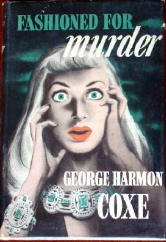
That’s a minor quibble. Forget I brought it up. Fashioned for Murder begins with Pason taking a series of photos of a model wearing some costume jewelry she happened to bring with her. The two of them hit it off, but a date they’d scheduled for later failed to come off. Pason decided to write it off as just one of those things until they meet again at another shoot.
The jewels, it seems, have caught someone’s eyes, Linda Courtney has become very popular, and she needs to tell Jerry about it. Not only that, when she does, Jerry becomes a target, too. The two of them are held up in his studio, and the fake jewels are stolen. (This is were the front cover comes in.)
Now you know as well as I do that the jewels are not phony, but it seems to take way too long for Linda and Jerry to catch on, even though he follows her back to Manhattan where she lives to check into some of the other strange things that had happened to her.
When one of the participants in the aforementioned activities comes to Linda’s apartment only to collapse dead on the carpet, Jerry commits an amateur detective’s most common mistake — he becomes an amateur detective. He decides to investigate the dead man’s flat himself and holds back evidence from the police, for reasons that almost sound good, but in reality are as substantial as the dental floss the rest of the story is stitched together from.
I even figured out who did it, which I have to confess does not happen all that often, so when it does happen, it is not my desire to pat myself on the back about it. As I said earlier, this is not one of Coxe’s better stories, but at least Linda and Jerry wind up in each other’s arms at the end.
Wed 6 Aug 2008
GEORGE HARMON COXE – Focus on Murder.
Pyramid R-1259; reprint paperback; 1st printing, January 1966. Cover by Frank Kalan. Hardcover edition: Alfred A. Knopf, March 1954. Hardcover reprint: Dollar Mystery Guild, June 1954. Previous paperback reprint: Dell 970, 1958.
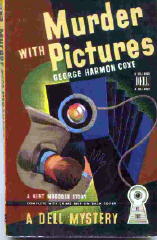
What with two paperback editions and (more importantly) a book club edition, this is not a difficult book to find, if you all you want to do is to have one to read.
In his prime, if Coxe was not a bestselling author like Gardner and Christie, his sales must have been steady if not spectacular, as his career in hardcovers began in 1935, with Murder with Pictures (with Kent Murdock) and did not end until No Place for Murder in 1975 (not with Kent Murdoch, but with PI Jack Fenner, who also appeared in that very first book).
Here’s something interesting. While Jack Fenner appeared in 12 cases chronicled by Coxe, his only solo appearance was that last one, which appeared when the author was 74. (Coxe himself lived another nine years, until 1984.)
Coxe is probably best known for his series character “Flashgun” or “Flash” Casey, a tough Boston-based news photographer who began his crime-solving in the pages of Black Mask magazine, circa 1934, but (after a quick double-check to confirm this) he wrote far many more novels in which Boston-based news photographer Kent Murdock appeared (23) than those in which Casey was the detective of record (only five).
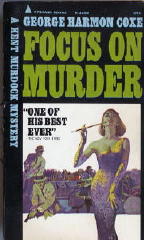
The difference in fame, relatively speaking, is probably due to the fact that Casey had a long-running radio show named after him, and two movies based on his exploits, while Murdock had neither.
Kevin Burton Smith over at his Thrilling Detective website suggests that Murdock is Casey with the rough edges smoothed off. Given Casey’s early pulp fiction days, he is probably quite correct in that assessment. Since their paths seem to have never crossed, that only adds credence to a hypothesis that one was really the alter ego of the other (and therefore could not appear in the same book at the same time).
Whatever. Although his roots were definitely in the pulps, I would still consider Coxe as an author solidly in the detective story tradition of the so-called Golden Age. If you do indeed come across a copy of this book, and if my review and other chatter convinces you to read it as well — which I certainly am attempting to do — be sure to strap yourself in for a fast-paced sequence of action and clues which you’ll have to keep your eyes on every minute of the way.
Let’s get the basic story line out of the way first. A colleague of Murdock’s at the Courier is found murdered shortly in his apartment after his (Murdock’s) departure, said colleague (as it turns out) having been a blackmailer in his spare time. That Murdock happened to have been in Ralph Stacy’s place of residence is important but not significant in the sense that he becomes one of the suspects –Lt. Bacon has worked with Casey before, and I’ll get back to this in a moment — but (as it turns out) an entire parade of suspects was in and out of the apartment and/or lurking around the building both before and after Murdock comes on the scene.
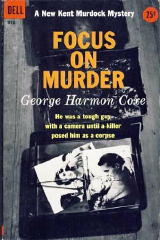
There is nothing like good old-fashioned (and dirty) blackmail to create a long list of such suspects, not to mention a wife who has just moved out, a current girl friend and a close boy friend of said girl friend, who just happens to be the jazz singer shown on the cover. Murdock is also personally offended by the murder in a personal sense, being a true-blood newspaperman through and through, nor can the reader help be offended as well.
Coxe also had an excellent insight into the way people in the real world (mostly male, I concede) react to tragedy and other things, which includes matters of right versus wrong, in a strangely tweedy sort of way. He also seems to have been quite the jazz aficionado. I won’t quote Murdock’s conversation with pianist Jack Frost about Art Tatum on page 80 — it’s rather long — but there is nothing said here about Tatum that anyone could possibly dispute.
By page 116, Lt. Bacon has (figuratively) thrown up his hands and asks Murdock, quite unofficially of course, to give him (Bacon) whatever assistance he (Murdock) can. And of course he (Murdock) does, again with neither the final flourish of a Christie or a Gardner (to pick a couple of prime examples) out of the air, but with the somewhat subdued manner of a magician whose apparent casualness catches you blinking, with the sudden understanding of just how easily the unwary reader (me, this time) can be taken in.
— March 2005 (slightly revised)
[UPDATE] 08-06-08. Well, as you can see, whatever reservations I had about Coxe’s plotting abilities in One Hour to Kill were completely non-existent in this Kent Murdock mystery published some ten years earlier. I’ll really have to read that other book again, as I simply can’t tell you if I was really as hard on it then as I’m reading into my own review of it now.
Other the other hand, I’ve just finished Fashioned for Murder (from 1947), and I didn’t find a whole lot to be happy about at all. (This is what prompted my going back and digging out these earlier two reviews.) I’ll get my review of it posted soon, but of course I will have to write it first.
« Previous Page — Next Page »









